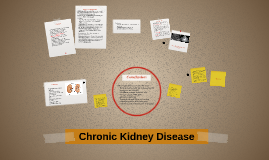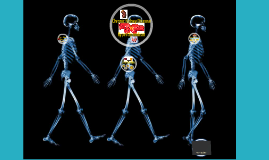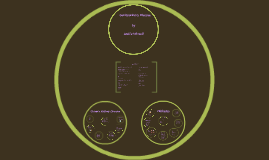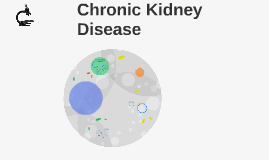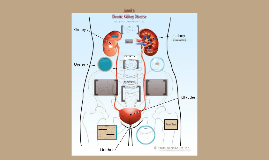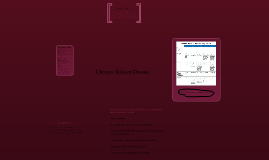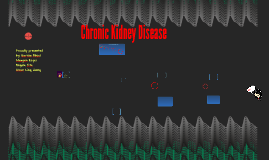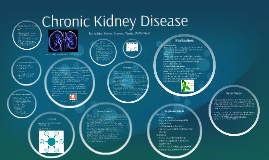Chronic Kidney Disease
Transcript: Table 1: Stages of diabetic nephropathy (Hill, 2009) Interventions Monitor daily weights (Weight reflects changes in fluid volume) Monitor Input and Output (Important with patients with fluid overload) Sodium Restricted Diet (2.3g/day-favors renal excretion of excess fluid) Implement fluid restriction (decreases intravascular volume and myocardial workload) Teach dietary restrictions : electrolytes, protein, fluid (Shown to decrease weight gain between dialysis treatments) (Ackley & Ladwig, 2011). Clinical Manifestations Lab and Diagnostic Tests Hypertension: r/t sodium and H2O retention and alterations of renin-angiotensin system Hyperkalemia: r/t decreased renal function, increased tissue catabolism, and shift of potassium into extracellular fluid secondary to metabolic acidosis Peripheral neuropathy r/t effects of uremia on peripheral nerves (Lewis et al, 2010). Summary *clinical manifestations vary *changes are very gradual Juanita 46 years old Native American Type 2 Diabetes Mellitus for 21 years Developing Chronic Kidney Disease (Van Leeuwen, Poelhuis-Leth, and Bladh, 2011). Post Test (Lewis et al., 2010) (Lewis et al., 2010) pump the blood safely clean the wastes from the blood monitor blood pressure and the rate of fluid removal from the patient’s body The hemodialysis machine will pump your blood through a canister called a ‘dialyzer’, which acts as a kidney by filtering the body’s waste products and fluids. (National Kidney and Urologic Diseases Information Clearinghouse, 2011) Client Scenario Nursing Diagnosis (Lewis et al., 2010) Excess Fluid Volume r/t edema resulting from oncotic fluid shift caused by serum protein loss and renal retention of salt and water Introduce client scenario Explain diabetic nephropathy & it's clinical manifestations Discuss diagnostic studies Identify indications and process of dialysis Provide related nursing diagnoses and interventions Summary of presentation Hemodialysis References: Objectives (Robins, 2010) Diabetes is the leading cause of kidney disease worldwide. occurs in 30–40% of diabetics after 25–40 years preventable occurrence prevalent in certain ethnic group (Evans & Capell, 2000) Interventions: Listen to the concerns of the client to convey a caring attitude and foster a relationship to determine how client is handling the situation Allow client time to mourn loss of body function so that client can deal with feelings and identify ways of coping with losses more effectively Include family members in discussions of client's concerns to enable them to assist the client and foster their support and understanding (Lewis et al, 2010). Dialysis Machine (Lewis, Heitkemper, Dirksen, O’Brien, & Bucher, 2010) Anorexia, Nausea, and Vomiting: buildup of toxins in the body; irritation of the GI tract Concentration Problems: hypermagnesia; neurologic changes; axonal atrophy and demyelination of nerve fibers Which comes first: the pruritis or the infection? (Casey, 2011: infection causes pruritis; Lewis et al., 2010: scratching can cause infections). Edema: retained Na Weight Gain: direct result of edema Dyspnea: fluid overload Weakness: ineffective ATP conversion; inability to utilize glycogen reserves Diagnosis (Lewis et al., 2010; Robins, 2010). Diabetic Nephropathy Juanita Chronic Kidney Disease Chest X-ray: Pathophysiology Activity intolerance r/t anemia and neuropathy AEB fatigue, shortness of breath, pallor, dyspnea, and tachycardia Ackley, B. J. & Ladwig, J. B. (2011). Nursing diagnosis handbook. An evidence based guide to planning care (9th ed.). St. Louis, MO: Mosby. Casey, G. (2011). The sugar disease -- understanding type 2 diabetes mellitus. Kai Tiaki Nursing New Zealand, 17(2), 16-21. Evans, T., & Capell, P. (2000). Diabetic nephropathy. Clinical Diabetes, 18(1). Retrieved on March 6, 2013 from http://journal.diabetes.org/clinicaldiabetes/v18n12000/Pg7.htm Headley, C., & Wall, B. (2007). Flash pulmonary edema in patients with chronic kidney disease and end stage renal disease. Nephrology Nursing Journal, 34(1), 15. Hill, J. (2009). Reducing the risk of complications associated with diabetes. Nursing Standard, 23(25), 49-55. [Table] Lewis, S.M., Heitkemper, M.M., Dirksen, S.R., O’Brien, P.G., & Bucher, L. (2010). Medical-surgical nursing in Canada: Assessment and management of clinical . problems. (2nd ed.). Toronto, ON: Elsevier Canada. National Kidney and Urologic Diseases Information Clearinghouse. (2011). Treatment Methods for Kidney Failure: Hemodialysis - National Kidney and Urologic Diseases Information Clearinghouse. National Kidney and Urologic Diseases Information Clearinghouse. Retrieved March 10, 2013 from http://kidney.niddk.nih.gov/kudiseases/pubs/hemodialysis Nazarko, L. (2011). Health risks in undiagnosed or poorly-controlled diabetes. British Journal Of Healthcare Assistants, 5(10), 479-482. Nurko, S. (2006). Anemia, in chronic kidney disease: Causes, diagnosis, treatment. Cleveland Clinical Journal of Medicine, 73(3), 289-297 O’Callagan,






